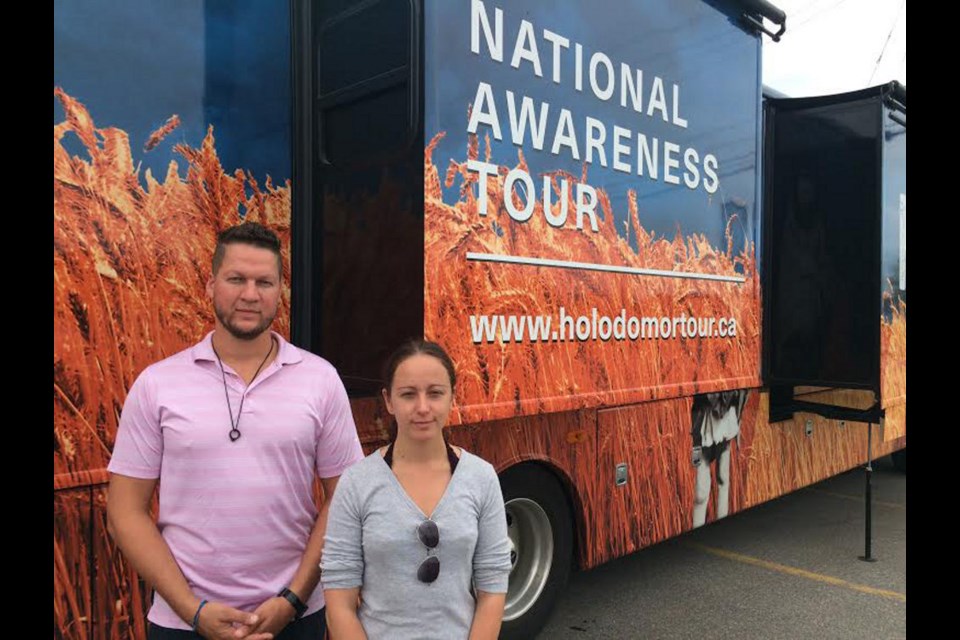The world must never forget the horrific genocide carried out against European Jews by Hitler's Germany in the Second World War.
Efforts are also continuing in regard to raising awareness of another genocide, one inflicted on Ukrainians by brutal Soviet leader Joseph Stalin in 1932-33.
To that end, the Holodomor National Awareness Tour bus parked at the Ermatinger-Clergue National Historic Site (at the site's south parking lot, facing Bay Street) Thursday.
Admission was free, though donations were welcome.
Visitors viewed a 20-minute educational film aboard the bus, shown on 12 screens spanning the length of the vehicle.
The film includes historical background on the Holodomor (Ukrainian for “death by forced starvation”), rare photographs of the the ordeal and videotaped recollections by survivors.
Educational DVDs and pamphlets were also available on the bus, and tour bus staff were on hand to interact with visitors and answer questions.
Toronto's Stephanie Bailey and London, Ontario's Kevin Viaene are travelling the country aboard the tour bus, also referred to as the Holodomor Mobile Classroom.
Both spoke to SooToday Thursday.
"I'm not of Ukrainian descent but I found it very important, I actually left my contracting business behind in London, Ontario, because I believed in the cause…it absolutely struck a chord with me, it's something that needs to be heard and needs to be known," Viaene said.
"The survivors are getting old and they deserve to know the story's being told," Viaene said.
Bailey is of Ukrainian descent and her grandmother (who recently passed away) survived the Holodomor.
"My grandmother lived through the Holodomor, she was very lucky, her family survived, all of her siblings lived through it and that was almost unheard of."
"The only reason her family lived through it was because her father was smart enough to hide food five kilometres back into the woods."
"She told me she remembered really well the NKVD soldiers (the former Soviet Union's state police, later known as the KGB) coming in and taking their horse, their cow and their chickens, it does strike a chord with me…my grandmother was about six or seven at the time."
Bailey's grandparents survived the Holodomor, and later, imprisonment by the Nazis before immigrating to Canada after the Second World War.
The Soviet Union denied the Holodomor ever happened for over 60 years, but with the collapse of the Soviet regime in the early 1990s, the truth came to light.
Stalin, who came to power in the Soviet Union in 1924, had already arrested, imprisoned and executed many of Ukraine's church leaders and intellectuals before starting his collectivization of Ukrainian farms in the early 1930s.
Those farmers who resisted collectivization were declared enemies of the state.
It is estimated one to two million of these people were deported or executed.
Ukrainian farmers who failed to meet unrealistic Soviet state quotas regarding wheat production had other foodstuffs, such as meat and potatoes, confiscated.
It also became a crime, punishable by death, to take as much as five stalks of grain.
Soviet state police searched Ukrainian homes for hidden food.
Starving families attempted to leave the country, but Soviet authorities forbade them from doing so.
Millions starved, while the Soviet regime exported confiscated Ukrainian wheat to the West.
"The genocide happened and Europe didn't respond, the West didn't respond and it was denied and covered up for decades after it happened, millions of people died during a time of peace in the USSR, and for so few people to know about such a huge part of history, that makes it important to make sure people know about it," Bailey said.
"Stalin had it under wraps, he managed the media in a way we should be scared about."
"The Ukrainian people went through such a hard, hard time," Bailey said.
"We can only try (to make sure genocide doesn't happen again)," Viaene said.
"We teach about the Holodomor on the grounds that we don't want to see it happen again…we want to equip people, equip students with the knowledge they need going forward to make sure they understand they have a voice that needs to heard, they can be active citizens in a democratic state where our freedoms are still, for the most part, intact," Bailey said.
"Most people who have gotten on the bus…had no idea it ever happened, but they seemed to appreciate we were there to show them the film, and they're happy to now know."
"You want to cry when you see it (the film), it's very emotional, you can't watch it without feeling the pain these people went through,it's horrible," said a visibly moved Huguette Lemay, a visitor to the bus Thursday morning.
"We're very fortunate to be here in Canada."
"It's unbelievable what people do to each other, especially to whole countries, it's unbelievable," said her husband Fred Lemay.
The Holodomor National Awareness Tour bus project has been made available through contributions from the federal government (Citizenship and Immigration Canada), the province of Ontario and donations from other sources such as the Temerty Family Foundation.
"We have enough money to do this for at least three years and we'll be writing grant applications again soon," Bailey said.
"It's been really interesting, a lot of fun and pretty intense."
The Holodomor project was in the planning stages for some time (since early 2015), but the bus itself has been on tour in earnest since April of this year.
The Holodomor National Awareness Tour bus spent Wednesday travelling from Thunder Bay and heads off to North Bay Friday.
More information on the Holodomor can be found here
